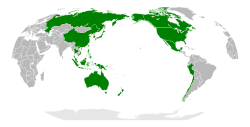From Wikipedia, the free encyclopedi
| The Asia-Pacific Economic Cooperation (APEC) | ||||
|---|---|---|---|---|
| ||||
| APEC member countries shown in green | ||||
| Headquarters | Singapore | |||
| Type | Economic forum | |||
| Member countries | 21 | |||
| Leaders | ||||
| - | APEC Chair | |||
| - | Executive Director | |||
| Establishment | 1989 | |||
| Website http://www.apec.org/ | ||||
Asia-Pacific Economic Cooperation (APEC) is a forum for 21 Pacific Rim countries (styled 'member economies') to cooperate on regional trade and investment liberalisation and facilitation. APEC's objective is to enhance economic growth and prosperity in the region and to strengthen the Asia-Pacific community. Members account for approximately 40% of the world's population, approximately 54% of world GDP and about 44% of world trade.[1]
An annual APEC Economic Leaders' Meeting, attended by the heads of government of all APEC members (with the exception of the Republic of China (ROC) which is represented under the name Chinese Taipei by a ministerial-level official at the behest of the People's Republic of China (PRC). The location of the meeting rotates annually among the member economies, and a famous tradition involves the attending Leaders dressing in a national costume of the host member.
History
In January 1989, Australian Prime Minister Bob Hawke called for more effective economic cooperation across the Pacific Rim region. This led to the first meeting of APEC in the Australian capital Canberra in November, chaired by Australian Foreign Affairs Minister Gareth Evans. Attended by political ministers from twelve countries, the meeting concluded with commitments for future annual meetings in Singapore and South Korea.
The initial proposal was opposed by countries of the Association of Southeast Asian Nations (ASEAN) which instead proposed the East Asia Economic Caucus which would exclude non-Asian countries such as the United States, Canada, Australia and New Zealand. The plan was opposed and strongly criticised by Japan and the United States.
The first APEC Economic Leaders' Meeting occurred in 1993 when US president Bill Clinton, after discussions with Australian prime minister Paul Keating, invited the heads of government from member economies to a summit on Blake Island. He believed it would help bring the stalled Uruguay Round of trade talks on track. At the meeting, some leaders called for continued reduction of barriers to trade and investment, envisioning a community in the Asia-Pacific region that might promote prosperity through cooperation. The APEC Secretariat, based in Singapore, was established to coordinate the activities of the organisation.
During the meeting in 1994 in Bogor, Indonesia, APEC Leaders adopted the Bogor Goals that aim for free and open trade and investment in the Asia-Pacific by 2010 for industrialised economies and by 2020 for developing economies. In 1995, APEC established a business advisory body named the APEC Business Advisory Council (ABAC), composed of three business executives from each member economy.
Member economies

APEC currently has 21 members, including most countries with a coastline on the Pacific Ocean. By convention, APEC uses the term member economy to refer to one of its members.
Member economy  | Date of accession  |
|---|---|
| 1989 | |
| 1989 | |
| 1989 | |
| 1989 | |
| 1989 | |
| 1989 | |
| 1989 | |
| 1989 | |
| 1989 | |
| 1989 | |
| 1989 | |
| 1989 | |
| 1991 | |
| 1991 | |
| 1991 | |
| 1993 | |
| 1993 | |
| 1994 | |
| 1998 | |
| 1998 | |
| 1998 |
India has requested membership in APEC, and received initial support from the United States, Japan[5] and Australia. Officials have decided not to allow India to join for various reasons.[6][7] However, the decision was made not to admit more members until 2010. Moreover, India does not border the Pacific which all members do. The Philippines trade negotiator was quoted as saying that there is concern that "Once the Indians come in, the (Asian) weighting would become heavier in this part of the world."[8]
In addition to India, Mongolia, Pakistan, Laos, Bangladesh, Colombia,[9] and Ecuador,[10] are among a dozen countries seeking membership in APEC by 2008. Colombia applied for APEC's membership as early as in 1995, but its bid was halted as the organization stopped accepting new members from 1993 to 1996,[11] and the moratorium was further prolonged to 2007 due to the 1997 Asian Financial Crisis. Colombia and Ecuador hope to become members in 2010. [12] Guam has also been actively seeking a separate membership, citing the example of Hong Kong, but the request is opposed by the United States, which currently represents Guam. APEC is one of the few international level organizations that Taiwan is allowed to join, albeit under the name Chinese Taipei.


